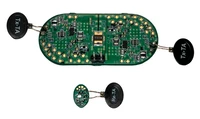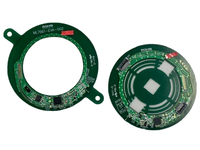QS6M4
2.5V Drive Nch+Pch MOSFET
QS6M4
2.5V Drive Nch+Pch MOSFET
Complex type MOSFETs(P+N) are made as low ON-resistance devices by the micro-processing technologies useful for wide range of applications. Broad lineup covering compact types, high-power types and complex types to meet various needs in the market.
For Automotive usage, please contact Sales.
Product Detail
Specifications:
Package Code
SOT-457T
JEITA Package
SC-95
Number of terminal
6
Polarity
Nch+Pch
Drain-Source Voltage VDSS[V]
30
Drain Current ID[A]
1.5
RDS(on)[Ω] VGS=2.5V(Typ)
0.26
RDS(on)[Ω] VGS=4V(Typ)
0.18
RDS(on)[Ω] VGS=Drive (Typ)
0.26
Total gate charge Qg[nC]
1.6
Power Dissipation (PD)[W]
1.25
Drive Voltage[V]
2.5
Mounting Style
Surface mount
Storage Temperature (Min)[℃]
-55
Storage Temperature (Max)[℃]
150
Package Size [mm]
2.8x2.9 (t=1.0)
Features:
· 2.5V-drive type· Nch+Pch Middle-power MOSFET
· Fast Switching Speed
· Small Surface Mount Package
· Pb Free/RoHS Compliant
Reference Design / Application Evaluation Kit
-

- Reference Design - REF66003
- Compact NFC Wireless Charge with 300mW Output
ML7661-EVK-001 is equipped with the power transmitting side LSI ML7661, and ML7660-EVK-001 is equipped with the power receiving side LSI ML7660. By facing the antenna, it is possible to output a power supply of 300mW. Wireless battery charging can be achieved in a small space.
The antenna is a product of Amphenol.
Datasheet Download:For any inquiries related to antennas, kindly use the inquiry form provided below.
Amphenol Website Contact Form
-

- Reference Design - REF67011
- NFC Telemetry-Based Rotating Component Torque Sensing
In this reference design, a strain sensor and the ML7660-EVK-002 are attached to the shaft. It is now possible to directly measure and collect data on the strain of the rotating shaft, which was previously impossible.
Specifically, the measurement process follows these steps:
1) The power supply LSI wirelessly supplies power to the power receiving LSI.
2) The power receiving LSI supplies power to the strain sensor via a wired connection.
3) The strain sensor measures the strain of the rotating shaft.
4) The strain sensor sends the strain measurement data to the power receiving LSI via a wired connection.
5) The power receiving LSI wirelessly transmits the measurement data to the power supply LSI.This reference design uses the STREAL SR300 sensor manufactured by Glosel. If you plan to use Glosel sensors, please check directly with Glosel for availability and procurement details in advance.
https://www.glosel.co.jp/en/contact/

